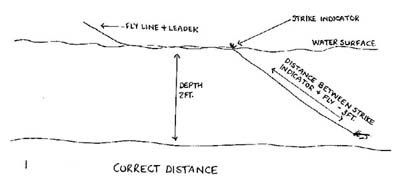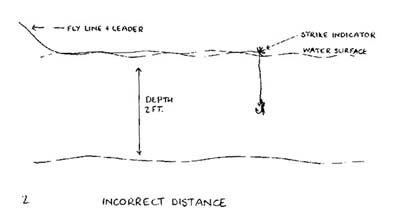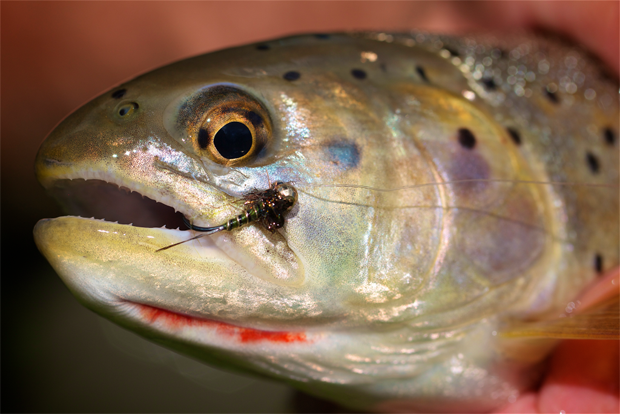Single fly nymphing
[dropcap]N[/dropcap]ymphing is artistically unappreciated, and for good reason; it is not a graceful pursuit of trouts or anything that swims. Lefty Kreh couldn’t even make it look pretty. However, done properly nymphing will catch fish, and plenty of them. ‘Properly’ is simple if you are OK with a little heresy.
Know the water flow dynamic. The water velocity is NOT the same throughout the stream, or even in a run just yards away
Flowing water moves fastest at the middle of the run and just below the surface. Trouts hover below all that water velocity and wait to dine. They face zero resistance in their hold. A holding fish without having to resist flow burns a minimum of calories while waiting for a those ‘nymphs’, and other morsels to tumble by. If your nymph floats by in a trout’s ‘feeding window’, you will get a bite.
What is a feeding window?
For example, a good major leaque batter will not swing at a ball that is thrown 1-foot over his head or 1-foot wide of the plate. Trouts, like most species of fish, have a better system. They will NOT spend more calories to catch less calories – so if your fly arrives outside that calorie window, sorry Charlie, no take.
With some trout holding positions, an errrant cast will spook it. A float-by nymph on the wrong off ramp will not spook a nymphed-for trout. That is, of course, if you have not done something to make its surounding theatening. Most species of fish spend their entire lifetime on predation alert.
Finding the feeding lane is not difficult. It is that funnel of foam and bubbles after a run
However, getting that nymph in ‘the’ lane is not as easy as spotting where a fish will most likely hold. A fly at the right depth is easier said than done.
Consider these factors when single fly nymphing
What is the ‘drag’ effect of your fly and leader? Of course, the bulkier/denser the nymph the more resistance, and consider the weight of the fly as well.
Nymphing success with the knowledge of stream flow velocity, leader and fly drag will put you in good stead
Constant but subtle mending with an indicator set up will put you in the feeding lane, but the fly has to be at the right depth. You are better off bouncing the fly along the botton than keeping the fly two feet from the bottom.

Strike indicator position sketchs by Fred Steynberg / www.linecasters.co.za
Where is the heresy?
Well, it really is not much in the way of heresy these days as most now understand that a tapered knotted leader or knotless tapered leader are both drag instigators and lead to spooking. A short, straight run leader of whatever X you think will govern a caught trout is all that is needed. A leader exceeding 8-feet generally makes things more difficult. Remember, casting is not at all what nymphing is about.
We have often preached the value of keeping lines slick when fishing for anything, and slick when nymphing is especially favorable. Leaders, like fly lines, pick up particles of debris from any water, oils from hands and dust from just sitting around.
A medical field fly fishing buddy introduced me to isopropyl pads. They are those little squares that come in sealed packets used for wound cleaning or a wipe by a nurse prior to a needle puncture. Keep a few of these packets in your pocket – one wipe of your fly line and leader and they are as if new. In seconds isopropyl is residue less, dry and odorless.
 A critical adjustment is what will catch em’
A critical adjustment is what will catch em’
Stream flow velocity will bend your leader/fly combo into a ‘U’ shape. The leader/fly will not drop straight down from the indicator so you will have to find an add to or subtract from the leader length to get the fly in the trout’s feeding lane window without that pronounced ‘U’ shape. Unfortunately, that is a trial and error process … unless you have a professional guide. A guide will instinctively know, for the water you will be fishing, that the leader needs to be shortened by X-inches or feet, or lengthened by X inches or feet.
Now, where to cast? Upstream or down? Make mine upstream
Critical: the indicator has to be upstream of the nymph. If not, it will be dragging the fly and no chance for a deep holding trout to be enticed. The trick: cast far enough upstream of planned intercept with the funnel feeding lane so that the sink rate and subtle mends get the fly on target
If you want to get a handle on two fly nymphing, using a dropper, read this . . .
NOTE: Featured Image is of cutthroat trout caught on a tugnsten copper nymph. Image by Fly Tying 123 . . .







